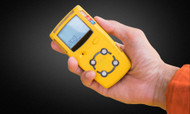The Major Advantages of Using an LEL Detector
Posted by William Kimmell on 28th Feb 2023
When you work at the same industrial facility every day, it’s easy to forget just how many hazards surround you. Dangerous equipment, chemicals, and power generators are just a few things you can probably find at your jobsite. That doesn’t even include invisible dangers like combustible gases in the air around you. Learn the major advantages of using an LEL detector to protect yourself from invisible dangers.
What Are Combustible Gases?
A combustible gas is a type of chemical that can catch fire when it’s mixed with oxygen. Particles of these chemicals can be in the air anywhere you go, but they’re more highly concentrated near industrial work zones. If there’s enough combustible gas in the air, there’s a constant danger of fire breaking out. The most common combustible gases are:
- Methane (natural gas)
- Hydrogen
- Propane
- Butane
What Does an LEL Detector Do?
LEL stands for lower explosive limit, and it refers to the minimum concentration of a gas in the atmosphere at which there’s a danger of fire. A 0 percent reading would mean that the air is free of all combustible gas particles, while a 100 percent reading would mean that the air is entirely combustible gas. Most combustible gases are only able to ignite within certain percentage ranges.
What Are the Advantages of Using an LEL Detector?
The main advantage of using an LEL detector is that it warns you when a small leak begins to spread, before it becomes dangerous. With this kind of tool, you can take extra care to fix these leaks before they endanger property or someone’s life.
LEL vs. Infrared Sensors
LEL detectors are catalytic bead sensors, and they detect combustible gases through the heat they give off when they oxidize. Infrared sensors use light absorption to do the same thing, but they only work in environments where there is either no oxygen present, or very high amounts of carbon dioxide. In most cases, you’ll want to use an LEL detector instead of infrared.
If you’re looking for stationary or fixed gas monitoring equipment, check out our stock at TG Technical Services. We carry dozens of different devices, including singular and multigas detectors. Not sure which device you need for your facility? Just give us a call or send us an email—we’d love to help!

